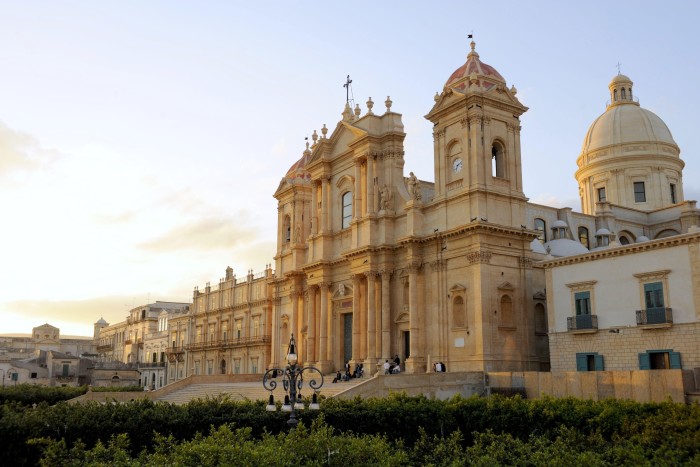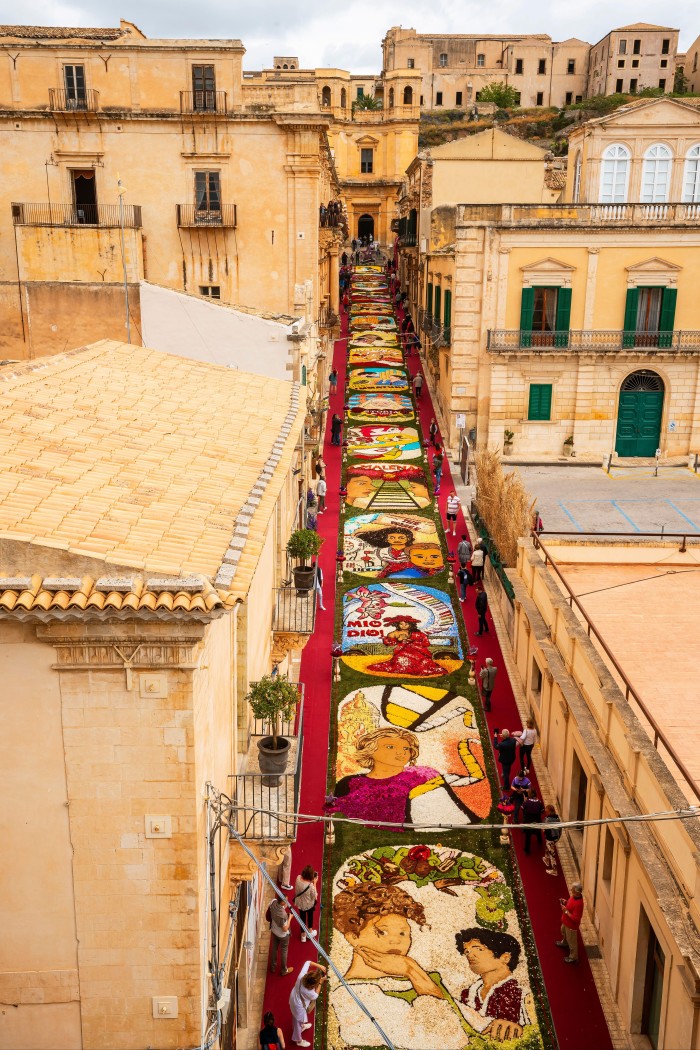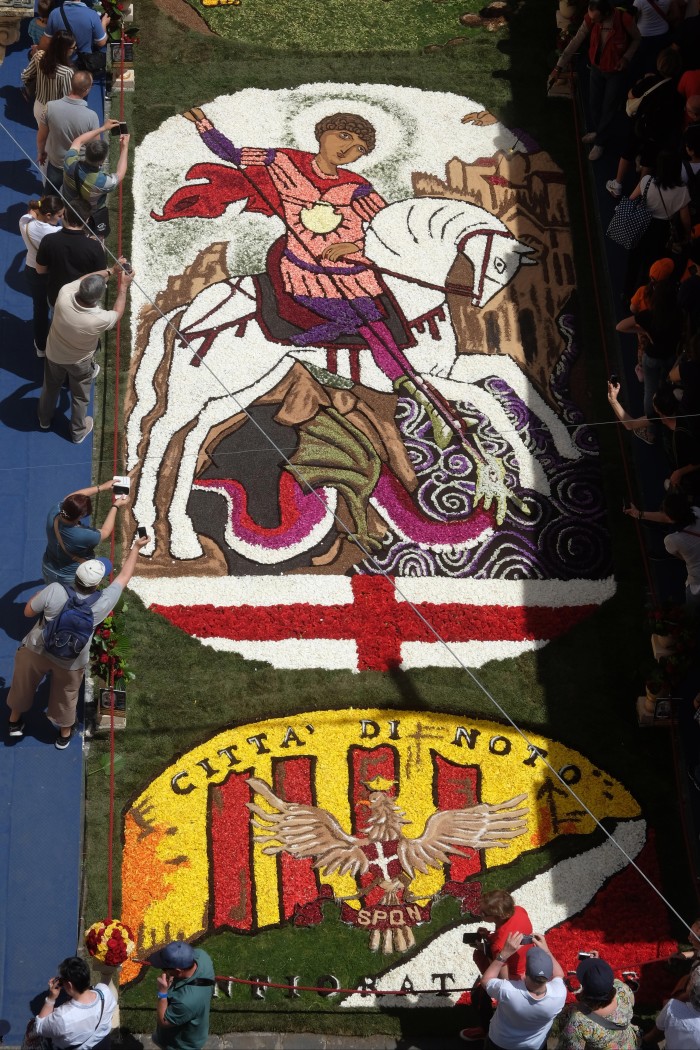Italian Catholics love outlandish celebrations. When I lived in Pisa, a fireman blithely climbed outside my riverside window one June morning to install a dozen of the 100,000 candles which would be lit for the San Ranieri luminaria, the annual light festival in celebration of the city’s patron saint.
The further south you go, the bigger — and blingier — religious festivities get. The August luminaria held in the Sicilian village of Novara looks like something out of a Las Vegas amusement park. In Barcellona Pozzo di Gotto, also on Sicily, the Holy Week religious parade features men in headpieces of peacock feathers half their height. In Messina, the traditional vara built to celebrate the Ferragosto holiday is a 14-metre, eight-tonne moveable tower adorned with angels flying in concentric loops underneath a life-size statue of Jesus, perched at the summit. It bears a striking resemblance to a Rio carnival float.
The religious and historical relevance of these festivities legitimates their extravagant taste, creating opportunities for grandeur that Italians can’t resist. But for all my research, nothing had prepared me for what I’d come to see in Noto.
When I arrived, on a hazy afternoon in May, there were no signs of what was about to happen. The historic centre, after lunch, was empty. A sleepy sun cast oblique shadows on the central square. Church bells, chiming somewhere far away, reverberated through the streets paved in sand-hued Modica stone. Sitting on a bench, an old man wearing a flat cap stared at me, smoking a cigarette.

Noto is famous for the Baroque architecture that has earned it a place on the Unesco World Heritage list. After a violent earthquake hit the Noto Valley in 1693, almost the entire town was rebuilt in the distinctively ornate style of the time. On via Corrado Nicolaci, a steeply rising street next to the cathedral, the palazzos have remarkable carved balconies — walking along it to my hotel, I marvelled at the watchful stone figures, mermaids, eagles, griffins and flame-tongued mythical monsters, petrified guardians of a lost glorious past.
On the third weekend of every May, those stone creatures overlook a modern festivity with ancient roots. Literally meaning “adorned with flowers”, infiorata started in Noto in the 1980s as a local iteration of the Catholic flower festivals historically celebrated in Genzano and Spello, during which whole streets are covered in freshly picked flowers. The colourful petal arrangements, seen from above, create vignettes which, traditionally, represented saints or passages from the Bible.
The practice harks back to the wreaths and bouquets that were hung on doors and windows during the feast of Corpus Domini in late spring, to be blessed with prayers for the upcoming harvest. But the specific tradition of drawing large carpets of flowers started in 1625, when the Vatican’s head florist Benedetto Drei decorated the basilica with a flower carpet which reproduced its mosaics. A few years later, a similar flower mosaic was created by Stefano Speranza, a close collaborator of the renowned sculptor and architect Gian Lorenzo Bernini. According to historians, after Drei’s death, Bernini himself picked up the practice of making flower carpets, and with him, infiorati spread past Rome.
Sipping a cappuccino at my hotel, a luxurious nine-room retreat called Q92, I absent-mindedly looked outside and found via Nicolaci abuzz. Under the hotel’s balcony, the street floor had been entirely coated in colourful fabrics, men in overalls walked carefully on the sidewalks carrying heavy bags of fresh flowers, and a group of local children, on the southernmost edge of the street, were carefully laying petals on the ground.


“They’re all fresh flowers cultivated here in Sicily,” the kids’ arts teacher, Angela Rossitto, told me as I walked past. “They arrived yesterday.” Noto’s infiorata flower carpet measures 700 square metres and is filled with seasonal daisies, roses, carnations and wildflowers. When I asked how many petals they would need, Rossitto looked up at the street, seemingly trying to do the maths in her head: “Every square metre requires about 800 flowers.”
Unlike other flower festivals, Noto’s infiorata has a modern spin: its 16 vignettes, drawn by local artists, follow a thematic brief that changes for every edition. Last year, when I was visiting, it was “cinema” and as the kids brought more petals up the street, I began to see their creations take shape. Many were nods to popular films shot in Noto: I recognised the profile of Monica Bellucci next to a rail line, a tribute to Giuseppe Tornatore’s erotic drama Malèna, which was filmed here in 1999. Another showed Aubrey Plaza as Harper, the reluctant nouveau-riche lawyer from the White Lotus, wearing a white cotton shirt and a neck scarf in front of an art deco mirror adorned with lotus flowers.
These gargantuan floral portraits, brimming with southern sensuality, could not be further from the biblical scenes that Drei first created in the Vatican. Yet, displayed as they were under slowly lifting clouds on a Sicilian morning, they certainly evoked a sense of community and its links with the past.
Among them, I spotted the 1968 billboard of the popular Italian comedy Meglio Vedova (“Better a Widow”), starring Virna Lisi and Peter Robert McEnery. In the picture, Virna was posing naked, her body only partly concealed by a curtain of black, horizontal ribbons. Fittingly she was holding a flower — not at all unlike a Tuscan madonna, portrayed in the springtime.
Details
This year’s festival runs from May 17 to 21; the theme is the composer Giacomo Puccini (on the centenary of his death). For details see infioratadinoto.it. Marianna Giusti travelled as a guest of Sicily Activities (sicilyactivities.com), which organises tailor-made itineraries, including hotels, travel, meals and private tours from €800 per day
Find out about our latest stories first — follow FT Weekend on Instagram and X, and subscribe to our podcast Life & Art wherever you listen

